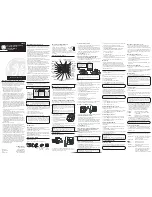
Peripheral Installation
PC/Data Communications Interface Units
Strata DK I&M 6/00
12-49
Pe
ri
p
h
er
a
l In
st
al
la
ti
on
EIA Interface Leads (Signals)
Both DIUs operate with 10 standard EIA RS-232 interface leads (signals) on which signaling data
is transmitted and received. RPCIs and DIUs connect to serial data devices with standard RS-232
cables, available from telephone supply stores (see
DI/PDIU-DI/PDIU-DS requires 10 signals for some applications, but can function with eight using
modular cords and connectors with RJ45/DB25 adapters for other applications. If uncertain which
signals are necessary for an application, all 10 should be connected.
See
Figure 12-32, “RPCI-DI, PDIU-DI, PDIU-DS SW1 DIP Switch Information”
for more
information.
Important!
♦
The RPCI-DI and PDIU-DI is always a DCE device; the PDIU-DS may be a DTE or DCE,
depending on how its internal jumpers (1~9) are configured.
♦
In the descriptions below, when a signal is On, its potential is about seven volts positive
relative to signal ground (pin 7); when a signal is Off, it is about 7 volts negative relative to
the signal ground (pin 7).
Frame Ground (FG, Pin 1)
The FG signal (EIA circuit AA) is a protective or safety ground which is bonded to the PDIU-DI/
PDIU-DS PCB. If required by local codes, the FG should be connected to external ground.
Signal Ground (SG, Pin 7)
The SG signal (EIA circuit AB) establishes the common ground reference for all other PDIU and
data device signals and must be wired for all applications.
Transmit Data (TD, Pin 2)
DTE devices transmit and DCE devices receive data on the TD lead (EIA circuit BA). Before the
DTE device can transmit the TD signal, the RTS, CTS, DSR, and DTR signals (all discussed
below) must be On. The TD signal is Off in the idle state.
Receive Data (RD, Pin 3)
The DCE device transmits data to the DTE device on the RD lead (EIA circuit BB); the DTE
receives data on the RD.
Request to Send (RTS, Pin 4)
Some DTE devices send an RTS signal (EIA circuit CA) to the DCE device when they are ready to
transmit data on the TD lead. If the DTE device does not generate the RTS signal, the DIU DIP
switch SW1-4 should be set On to inform the RPCI or DIU. Sometimes, the DTE/DCE device may
use RTS/CTS for Ready/Busy type flow control, in these cases DIP switch SW1-4 should be Off.
Clear to Send (CTS, Pin 5)
The DCE device sends the CTS signal (EIA circuit CB) which indicates that it is prepared to
transmit data to the line side. The DCE device sends this signal only when it receives the RTS
signal from the DTE device. Sometimes, the DTE/DCE device may use RTS/CTS for Ready/Busy
type flow control; in these cases, DIP switch SW1-4 should be Off.
Summary of Contents for Strata AirLink DK40i
Page 22: ...Introduction Related Documents Media xx Strata DK I M 6 00 ...
Page 48: ...DK14 Installation DK14 Wiring Diagrams 1 26 Strata DK I M 6 00 ...
Page 220: ...DK424 Installation Remote Cabinet Installation Instructions 5 68 Strata DK I M 6 00 ...
Page 262: ...DK424i Configuration Primary Reserve Power Cabinet Hardware 6 42 Strata DK I M 6 00 ...
Page 450: ...Universal Slot PCB Wiring Option Interface PCB Wiring Diagrams 10 42 Strata DK I M 6 00 ...
Page 592: ...Peripheral Installation Enhanced 911 Service E911 12 84 Strata DK I M 6 00 ...
Page 616: ...ACD Installation Spectrum Electronic Wall Boards 13 24 Strata DK I M 6 00 ...
Page 634: ...Fault Finding Fault Isolation Flowcharts 14 18 Strata DK I M 6 00 ...
Page 704: ...ISDN Interfaces ISDN Disconnect Cause Code 16 54 Strata DK I M 6 00 ...
















































